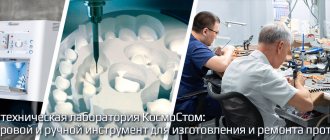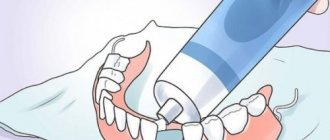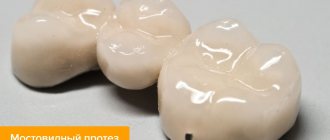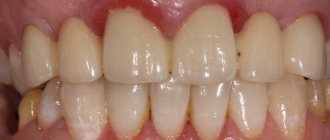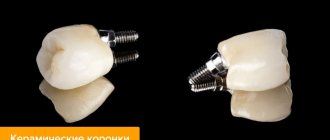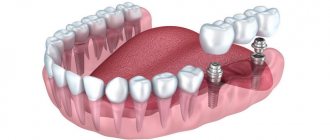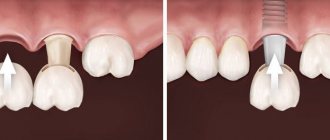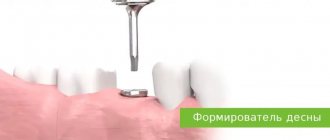- Causes
- Prices
- Work examples
- Doctors
- Reviews
Despite the high-tech methods of dental prosthetics, situations where dental crowns fall out still occur. Common reasons:
- Excessive mechanical impact during chewing, if there is a hard piece in the food;
- destruction of tooth remains, the prosthesis does not fit tightly to the stump, this is a consequence of unprofessional canal treatment before prosthetics;
- poor-quality prosthetics, stump too pointed to a cone;
- destruction of the cement composition that secured the crown.
In any case, figure out the situation: what to do, how to urgently consult a doctor, can it be installed again or will you have to get prosthetics again?
Pak Roman Vladimirovich Dentist-orthopedist, doctor of the highest category
My crown fell off, I immediately found it, wiped the prosthesis and tooth stump with alcohol, and glued it into place myself. Do I need to see an orthopedist?
Yes, definitely
Pak Roman Vladimirovich Dentist-orthopedist, doctor of the highest category
My stump under the crown began to crumble. The prosthesis began to wobble, contributing to even greater destruction. I wouldn’t want to have to re-prosthetize because I had the crown installed in St. Petersburg, it’s zirconium and not cheap at all. What options?
If a zirconium crown is loose, come to our clinic immediately to solve the problem as budget-friendly as possible. The orthopedist will suggest options after the examination.
The first piece of advice for those whose tooth crown has fallen out is to examine the prosthesis and visually determine the degree of integrity. If it is intact, then the chances that it will be reinstalled rather than new prosthetics are high. Until your appointment with the dentist, keep it in a cool place, after rinsing it and wrapping it in cotton cloth.
People whose crown has fallen out of a tooth immediately note hypersensitivity of the ground stump. Clove oil applied to it will help reduce pain symptoms. Go to see a doctor right away, because in addition to the pain that a bare, ground tooth causes, it is also prone to destruction from impact. If you cannot get to the dentist for treatment in the next few days, try fixing the crown. Use dental cement purchased from a pharmacy for this. The procedure is not the solution to the problem. Rather a forced temporary measure.
If the dentist gives you a verdict of “re-prosthetics”, ask for arguments for the decision:
- We are talking about additional expenses (the price of the crown is high).
- This will require additional processing of the remaining tooth. They will become even smaller, and the fixation of the new one will be less strong.
When contacting a professional, you are sure that the fact of falling out and re-installation is visually invisible. Make sure of this from the photos presented in the galleries of the clinics’ websites.
Article Expert
Pak Roman Vladimirovich Dentist-orthopedist, doctor of the highest category
Work experience: more than 29 years
Is it possible to remove the crown?
Almost every patient who has undergone orthopedic treatment wonders whether it is possible to remove the crown from a tooth. Installing a crown is a non-removable type of prosthetics, but this does not mean that they cannot be removed in principle. In dentistry, removable dentures are those structures that can be pulled out of the mouth independently. In turn, fixed dentures are removed in the dentist's office using special equipment and tools. Another popular question: which doctor removes crowns from teeth? This should be done by an orthopedic dentist, but in some clinics the therapist also removes crowns, which, of course, is not entirely correct.
Additional means of fixing dentures
Additional means include special compounds that help to hold removable structures due to their properties - viscosity and adhesiveness. You can buy them at any pharmacy. They are indispensable when devices are at the very beginning of use and can cause some discomfort, as well as over time, after several years of active use, when the fastening system gradually weakens. How can you additionally secure a denture:
Fixing adhesives, creams and gels
They are presented in a wide range on the market. Their composition is approximately the same, the adhesion of the surfaces occurs due to the action of polymers that glue them together. There are well-known products to choose from: Corega, Rox, Fittident, Protefix and others. They can be used to fix a complete removable denture, both lower and upper, as well as partial, on the gums. If the device falls out of your mouth, glue or cream will help to quickly secure it.
Which of these is better for fixing dentures depends on the doctor’s recommendations in a particular case, the presence or absence of allergies, the condition of the oral cavity, and personal preferences.
Which cream is best suited for each specific situation, read the article on the website “Review of the best creams for fixing dentures: features of composition and application.”
Special prosthetic pads
They are available for lower and upper removable devices. Made of special fiber in the shape of an arc on the gums or plates on the palate. They serve as a layer between the structure and the gum, providing stability. Their function is to protect the mucous membrane from chafing when getting used to the devices, and to securely hold it.
Read more about this product in the material “Why do you need spacers for dentures: application features and a review of popular brands.”
Special stripes
They are similar to gaskets, but are used if there are bite pathologies. They are coated with an adhesive composition, which must be heated in warm water before use. The warm strip is glued to the denture and inserted into the mouth along with it. This remedy protects the mucous membrane from displacement of the apparatus and the occurrence of inflammation, and if it occurs, it reduces pain and promotes tissue healing.
Powder products
Also an adhesive composition, but in powder form. It is necessary for those patients who have insufficient salivation. The powder “seizes” in the mouth and holds the structure well. True, it is more difficult to distribute evenly than paste-like products.
Which of these fixes dentures better depends on the patient’s situation, at what period of wearing he turned to the help of these products, as well as what is the situation in the oral cavity, whether there are inflammations, wounds, etc.
Why is crown removal necessary?
The average lifespan of a standard crown that covers a natural tooth is about seven years. If the crown is installed on an implant, then it may well last for fifteen years. As a rule, the removal of a crown from a tooth is carried out for a number of reasons.
- Errors during prosthetics. Most often, the fault lies with specialists who made a mistake at one of the stages of treatment. Incorrect manufacturing of the product, incorrect calculations at the preparatory stage, the use of low-quality materials - all this leads to the fact that the prosthesis cannot function properly and has to be removed.
- Injuries and mechanical damage, after which further use of the dental crown becomes impossible.
- Diseases developing under the crown. Secondary caries, periodontitis, cysts are complications in which tooth treatment without removing the crown is almost impossible.
- Gum diseases requiring removal of the denture for treatment procedures.
- Expiration date. Each crown has its own lifespan (especially when installed on a natural tooth). If a crown has lost its functional and aesthetic qualities over time, it must be replaced. Often the crown falls out on its own due to damage or destruction of the bonding agent.
- The desire of the patient himself. For example, in order to replace an old metal or metal-ceramic structure with a more modern and aesthetic product.
Dangerous symptoms!
- Constant pain under the crown indicates the development of an inflammatory process and the need for re-treatment.
- Unpleasant odor concentrated in the crown area. It usually occurs due to the decomposition of tissue under the crown or the ingress of food particles, which indicates a violation of the seal.
- The crown becomes mobile. This is due to decay of the tooth or dental cement under the crown.
If you experience the above symptoms in one form or another, we advise you to contact your dentist as soon as possible. After taking an x-ray, it will become clear whether you have a hidden problem and whether the crown needs to be removed.
What to do if it is not possible to see a doctor immediately
- Apply clove oil to the tooth and the pain will decrease.
- Wash the crown and install it on the tooth using cement, which is sold in the pharmacy chain. It is not advisable to do this, but if you contact your dentist and get the go-ahead, you can fix the product temporarily, according to the recommendations of a specialist. You should first rinse your mouth with an antiseptic.
- If necessary, you can take painkillers.
- If the crown falls off and cannot be found, you can simply lubricate the tooth with pharmaceutical cement - this technique will somewhat reduce the discomfort.
How are crowns removed from teeth?
There are several ways to remove dental crowns.
Sawing
An old and rather crude way. After this, it is no longer possible to remove the crown and put it back. The technique is considered cheap and quite effective, but the final success largely depends on the experience of the doctor - a tooth or gum may be damaged in the process.
Removal using a Kopp apparatus
The Kopp apparatus is a special tool that resembles both a refueling nozzle and a hook (due to the hook-shaped nozzle). The doctor grinds off the cement at the base of the crown, then picks it up with a tool and presses the release. This is a fairly quick and effective method with the only drawback - during the extraction process, chips of the prosthesis may occur.
Ultrasonic crown removal
Involves destruction of cement using ultrasound. The method is well suited for removing old crowns. However, if the material is too dense and strong (for example, glass ionomer cement), ultrasound may not be able to cope with it.
Removal using the Coronaflex device
The operation of the Coronaflex device, which looks like a pistol from the future, is based on the principle of compressed air. The air flow is supplied under high pressure, destroys the cement, but at the same time has a gentle effect on the crown and adjacent tissues. Removing a prosthesis using a device will cost significantly more than other methods. However, if you have a zirconium crown costing 25,000 rubles, it makes sense to overpay a little.
Protefix
The manufacturer guarantees reliable fastening of the removable denture for 12 hours. The product has medium viscosity.
The following varieties of Protefix are produced:
- With mint. It is recommended for use during the period of getting used to the prosthesis; the main component of the product is mint essential oil, thanks to which the gag reflex is reduced. When using the product, gum trophism improves and inflamed tissues calm down. The product is hypoallergenic, does not contain fragrances or dyes, which is important for people with sensitive gums and a tendency to allergic reactions.
- Extra strong. Contains fixing components in the maximum dose, so the installation of the prosthesis occurs in the shortest possible time. After the structure is placed in the oral cavity, you need to wait only 5 minutes, not 15, after which you are allowed to drink and eat.
- With aloe vera. This glue should be used by people with irritation, chafing, redness and swelling of the oral mucosa, as the product has anti-inflammatory and bactericidal properties. The use of the composition ensures the prevention of dental tissue, improves metabolism, and normalizes the process of soft tissue restoration.
The glue manufacturer is German, which is known throughout the CIS thanks to the products of the Doppel Hertz series. The quality of the glue complies with the standards and regulations that apply in the EU and Germany.
- is used sparingly;
- holds well;
- does not affect taste sensations;
- can be used for severe salivation;
- Can be applied to dry or wet prosthesis;
- side effects are almost completely absent;
- has no taste or pungent odor.
Flaws:
- small packaging volume;
- not very convenient dispenser;
- The tube must always be positioned vertically, otherwise the composition will leak out of it.
Advice! "Protefix" should not be used by people allergic to aspirin, as well as by those who have damage to the oral mucosa.
Does it hurt to remove a crown?
No, especially if the procedure is performed under anesthesia. Removing a crown from a tooth is painful if there is a living tooth underneath it that is undergoing an inflammatory process, but in the vast majority of cases, crowns are placed on pulpless teeth. In such a situation, the procedure may cause some discomfort, but you most likely will not experience severe pain. If your teeth hurt after removing crowns, there are two options. Either mechanical damage has been caused to the gum, or pulpitis, periodontitis or granuloma develops in the tooth. In this case, complex endodontic treatment is required.
Rules of conduct when a bridge falls out
What to do if a dental bridge falls off? Often people get lost and don’t know how to behave. Someone almost begins to panic, someone hastily throws the fallen orthopedic structure into the trash. The list below includes simple and understandable rules that will tell you what to do when a dental bridge falls out:
- carefully spit everything out of your mouth onto a napkin if it falls out while eating,
- rinse your mouth with water and then with some solution (chlorhexidine or mouthwash),
- rinse the bridge in clean water, you can clean it with a soft bristle brush: when rinsing and cleaning, make sure that it does not fall into the sink or onto the floor,
- place the prosthesis in a clean handkerchief or piece of sterile bandage,
- put the bridge in a small, clean container so as not to accidentally break the product (in case it can be glued back, although this is unlikely). You will need to take the prosthesis to the clinic in the same container,
- try not to chew on the “affected” side, and also rinse your mouth after each meal (if there is still a lot of time before your visit to the clinic).
When the bridge falls out from clenching the jaws, from pressing with the tongue - that is, when there was no food in the mouth, then immediately go to point number “2” of this list.
If it suddenly turns out that the bridge was swallowed along with food or liquid, then you need to immediately contact a clinic - for example, a therapist, pediatrician, or a hospital emergency room. The sharp edges of the structure can injure the gastrointestinal tract; the bridge can get stuck in the esophagus or intestines. Therefore, you will need to undergo an x-ray or ultrasound. It is important not to make active movements, not to bend over and to adhere to the diet prescribed by the doctor - so that the structure leaves the body naturally. Otherwise, you will have to undergo emergency surgery.
Treatment of a tooth under a crown without removing it
In dental practice, there are cases when it is possible to cure a tooth without removing the crown. Usually we are talking about secondary caries and simple endodontic manipulations, carried out through a hole, which is then filled with a composite material. In some cases of surgery, such as cyst removal, the surgical site is accessed through an incision in the gum. In this case, the product usually still has to be removed for additional manipulations.
Recovery technique in the clinic
At the dental clinic, the doctor initially examines the device visually. It should be examined by a dental technician. If pieces of food and other foreign objects are stuck in the denture, pre-clean it. Only after this can you accurately see all the defects and begin the restoration of the structure. If you exclude the cleaning step, the adhesive will not be able to completely fix the broken product. Then the repair procedure will be ineffective. Only after cleaning can high-quality sealing be achieved.
If the defects in the device are excessively large, the dentist will recommend completely replacing the structure. This is due to the following features:
- saving money, since repairs may require similar financial resources as major repairs;
- the possibility of a lack of quality effect during repairs; the base will continue to break, damage tissues, and disrupt the bite.
Only if minor chips or cracks appear on the prosthesis, it can be restored. For example, if a small chip occurs on the crowns, remove the device and fix it. Why install the crown in place? The result should be a product that is not inferior in function to new prostheses.
Many patients believe that they can handle the repair themselves. But there is a big difference between home bonding and professional services. At home, you can make a little adjustment to the design before going to the dentist. Complete repairs can only be carried out by a competent dental technician. He must have specialized tools at hand in order to carry out high-quality restoration.
The patient does not have solutions or tools at home that will return the whiteness to the crowns on the prosthesis. Periodically, it is necessary to restore the shade in order for the prosthesis to perform an aesthetic function. It should completely replace the appearance of real teeth.
It is not always possible to achieve high-quality restoration after repair, even from a dentist. For example, if a stamped device or a product without metal is damaged, it cannot be repaired.
Repair price
The cost of restoring the quality of a denture after repair depends on the following factors:
- the complexity of the work performed by a dental technician;
- product material;
- area and degree of damage.
For example, if a patient’s metal-ceramic structure is slightly broken, repairs can reach up to 2,000 rubles.
The following approximate price list is highlighted:
- installation of a new artificial crown - 2500 rubles;
- professional cleaning and whitening of crowns, basics of the device - 1000 rubles;
- restoration of crown shade when drinking coffee, after prolonged smoking - 1200 rubles.
If you carry out the restoration yourself, the price will be significantly lower, but the entire structure will not be able to regain its original appearance. The damage may recur or continue to get worse.
